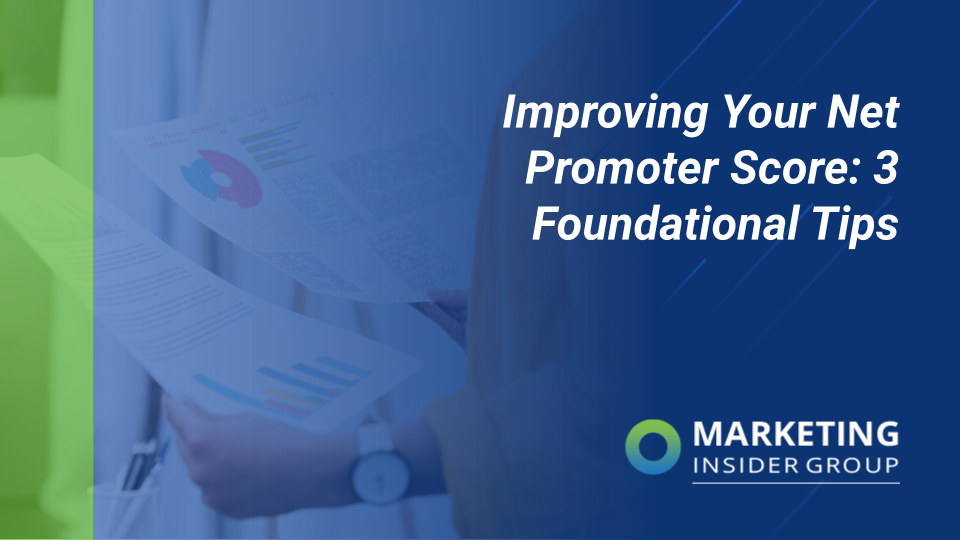Improving Your Net Promoter Score: 3 Foundational Tips

A high net promoter score (NPS) is among the most valuable assets any business can have.
This metric measures the eagerness and likelihood of your customers to recommend your business to friends and peers. A healthy NPS is a sign of excellent service and value delivery, and it can be a powerful way to drive business results.
Bain and Company found that more than 80% of positive referrals come from promoters, or highly satisfied and engaged customers, while 80% of negative word-of-mouth comes from detractors, or actively dissatisfied customers. In an environment where another roughly 80% of new leads never turn into sales, a steady referral pipeline of warm leads can be a gamechanger.
Understanding who these satisfied customers or “promoters” are and how you can improve your relationships with them can translate directly to increased revenue and improved customer retention, acquisition, and lifetime values.
However, a strong NPS isn’t created overnight. It can’t be bought, although it can certainly be invested in and actively fostered over time.
Today, it’s easy to get up and running with customer satisfaction tools and start collecting satisfaction and promoter feedback. However, this information isn’t nearly as useful (or valuable in the long run) if it’s not part of a more intentional underlying strategy or structure. Strategically and consistently improving your NPS requires data collection and analysis, careful thought, and a robust customer experience (CX) strategy.
If you’re new to NPS and customer experience analytics, these foundational tips will help you get started. Let’s dive in.
Actively talk about NPS, and measure it constantly.
To start improving your net promoter score, it has to be on your organization’s radar in the first place. Make it an intentional focus across your various teams. Try these strategies for boosting awareness of NPS as a strategic priority for your business:
- Explain why NPS matters. Share and discuss educational resources with your teams.
- Walk through how NPS relates to each role or department. Review your customer journey maps together and consider the make-or-break points that can impact NPS.
- Hold frequent huddles or other quick meetings specifically for the purpose of reviewing customer feedback and trends.
- Actively recognize employees for positive customer feedback. Incentivize teams based on NPS and customer outcomes rather than solely talking about it in terms of revenue.
You’ll also need concrete mechanisms for measuring NPS. Do this by collecting feedback directly from customers at different points in their journeys with your business.
Ideally, this feedback collection will occur continuously (more on this below), but it’s most important that it at least occurs consistently. Only asking customers for brief satisfaction and promoter feedback once a year is not useful and could even be harmful. Conditions change quickly, so it can be easy to operate under outdated assumptions if you’re working with limited data.
Additionally, ensure that you’re collecting enough information to make actionable connections and conduct root cause analyses of recurring customer pain points. Rather than just asking for a rating of their likelihood to promote your business, ask customers for a little more detail so that you can attach specific outcomes to particular teams, products, experiences, or segments.
Ask the right customers for their feedback.
Of course, there’s a lot of value in asking all of your customers for regular feedback on their experiences and the likelihood that they’ll recommend your business to others. But it pays to get more strategic and specific with who you ask and when.
You’re already familiar with the concept of segmenting your customers in order to better target them with tailored messaging and learn more about how they like to engage with your business.
This same concept should be applied to your feedback and voice of customer program so that you can actively use them to generate maximum value based on your current top priorities. For example, you might focus specifically on asking for feedback from these groups:
- High-impact customers, those whose transactions are particularly important for your business in terms of volume or value
- Newly acquired customers so that you can learn more about the initial experience you offer and how it may impact long-term retention
- Long-term customers so that you can learn more about what drives retention and ways that you can encourage future engagement
- Customers at particular points in their journey, for instance during a software onboarding phase or shortly after submitting a support request
We consider your high-impact customers to be a segment that especially warrants attention, particularly when it comes to NPS improvements. These customers have a significant impact on your business and are likely well-connected or influential in their spaces. Proactively seeking their feedback allows you to:
- Immediately identify red flags
- Learn more about the experience you’re offering these customers and how it could be improved
- Ask for referrals from satisfied high-impact customers.
But you can use your feedback collection process to learn more about any segment based on your business’s current priorities or emerging trends.
For instance, if you’ve seen increased customer or client churn, find out if there’s a common point in their journeys where they’re churning. Then target customers with NPS and feedback surveys leading up to that point. You may see steadily declining NPS scores and recurring points of negative feedback related to processes that you can improve (or didn’t even realize were the culprit). Or, if you’ve just implemented an improved customer service process or other internal improvement, use surveys to learn more about how those changes are impacting customer satisfaction.
One important note for B2B organizations:
Be sure that your feedback collection process targets both your key stakeholders and your end users.
Stakeholders make important buying decisions, but their understanding of your product or service’s value is fully shaped by how end users actually use it. If the end users of an enterprise software platform struggle to use it correctly, the organization might not see a strong ROI. The purchaser or stakeholder might simply know that ROI has been poor but be unable to provide more detail to help you resolve the issues.
Whenever possible, expand the reach of your surveys within client organizations so that you can get a full picture of the experience and pinpoint areas that impact your NPS.
Make NPS part of a larger CX program.
We’ve touched on the broader concept of customer experience (CX) throughout these tips so far. CX is the idea that all of your touchpoints with customers—before, during, and long after their transactions—shape their perceptions of your business and their likelihood to return. NPS is one way of measuring your progress towards CX success.
This means you shouldn’t focus too narrowly on NPS alone. Strong net promoter metrics are the result of a positive customer experience, which can be influenced by an incredibly wide range of factors. An effective CX strategy helps you learn more about and improve those factors, which will then bolster your NPS efforts.
A CX program should be continuous, that is, it involves constantly collecting information through ongoing loops of feedback and iterative improvements. Here’s how the process works:

- Identify or create an intentional experience that you want to learn more about. How is it experienced by customers? How does that experience shape their perception of your business?
- Measure your performance using targeted customer surveys. Collect the information you need to know, perhaps including overall satisfaction or promoter feedback as discussed in Tip #2.
- Manage the experience proactively and in real-time based on the feedback you collect. Make changes to your process, and look for trends over time.
- Keep it running as a feedback loop. Continuously improve the experience you offer by making iterative improvements based on feedback.
It’s a fairly straightforward process, but it’s immensely valuable for making targeted improvements in a data-driven, systematic way. After all, if you’re looking to improve your customers’ experiences, what better way than to make changes based on their actual feedback rather than vague hunches?
In terms of improving your NPS, a robust CX strategy gives you all of the additional data and context you need to make valuable correlations and focus your efforts to maximize impact.
For example, with a wealth of feedback to study, you can easily look for trends in NPS by customer segment. And as you develop a fuller and clearer picture of your entire customer journeys over time, you’ll learn more about the chronic pain points or pivotal “moments of truth” that have the most impact on NPS outcomes. These are the areas where deeper research and improvements will drive the greatest NPS results.
The bottom line: Don’t approach NPS as a siloed endeavor. It’s one part (or a result) of your broader customer experience. A robust CX program gives you the tools and context you need to see the best possible NPS results.
A healthy and continuously improving net promoter score is a sign of a standout business, one that customers truly enjoy engaging with and will gladly recommend to friends and peers. If you’re not actively measuring your NPS, you’re missing out on the ability to strategically and sustainably improve it.
To get started, learn more about NPS. Make it an explicit priority in your business, and help everyone understand how their role can impact it. Create a feedback collection process to begin measuring it, and consider how your approach could be tailored to best support your top priorities. Finally, remember that a broader CX strategy will strengthen the entire process.
 Sean McDade has been helping companies optimize customer experiences for over twenty years. An angel investor in the Philadelphia region, he is also the founder, CEO, and visionary of PeopleMetrics, a leading provider of experience management software and advisory services. In addition to working with a number of leading pharmaceutical and biotechnology companies, he is the author of two books.
Sean McDade has been helping companies optimize customer experiences for over twenty years. An angel investor in the Philadelphia region, he is also the founder, CEO, and visionary of PeopleMetrics, a leading provider of experience management software and advisory services. In addition to working with a number of leading pharmaceutical and biotechnology companies, he is the author of two books.
The post Improving Your Net Promoter Score: 3 Foundational Tips appeared first on Marketing Insider Group.




